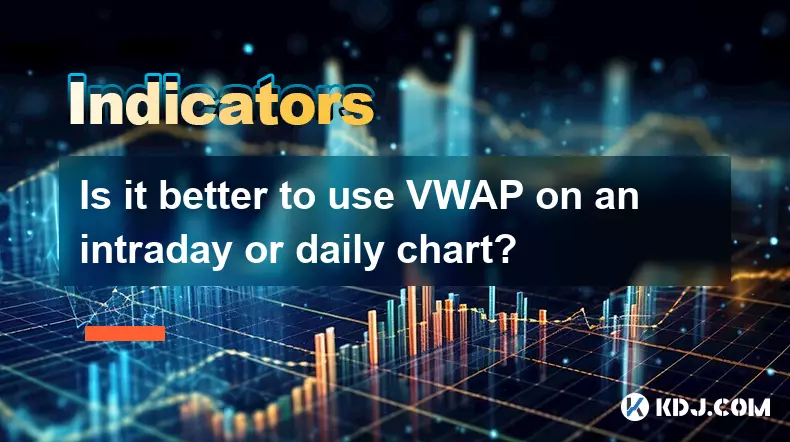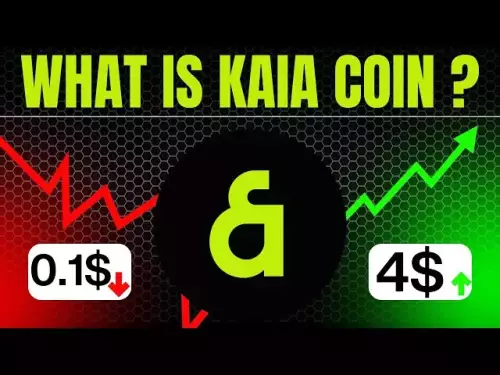-
 bitcoin
bitcoin $112715.707551 USD
-1.71% -
 ethereum
ethereum $4101.475385 USD
-3.01% -
 tether
tether $1.000644 USD
-0.02% -
 bnb
bnb $1207.619465 USD
-6.77% -
 xrp
xrp $2.501451 USD
-3.98% -
 solana
solana $202.947124 USD
-3.32% -
 usd-coin
usd-coin $1.000295 USD
0.04% -
 dogecoin
dogecoin $0.203884 USD
-4.47% -
 tron
tron $0.317154 USD
-1.72% -
 cardano
cardano $0.695009 USD
-4.43% -
 hyperliquid
hyperliquid $38.853961 USD
-8.23% -
 chainlink
chainlink $18.988674 USD
-4.64% -
 ethena-usde
ethena-usde $1.000233 USD
-0.03% -
 stellar
stellar $0.337050 USD
-3.63% -
 bitcoin-cash
bitcoin-cash $536.861728 USD
-1.28%
How to use KDJ indicator signals for trading Bitcoin?
The KDJ indicator helps Bitcoin traders spot momentum shifts and reversals using K, D, and J lines, with overbought (>80) and oversold (<20) levels offering key entry/exit clues.
Oct 10, 2025 at 12:54 pm

Understanding the KDJ Indicator in Bitcoin Trading
1. The KDJ indicator, also known as the Stochastic Oscillator with a J-line adjustment, combines three moving lines—K, D, and J—to assess momentum and potential reversal points in Bitcoin’s price action. It operates on the principle that during an uptrend, prices tend to close near their highs, while in downtrends, they close near their lows.
2. The K line is the fastest, calculated from the current closing price relative to a specified price range over a set period, usually 9 candles. The D line acts as a signal line, being a moving average of the K value. The J line, derived from 3 times the K value minus 2 times the D value, provides early signals for overbought or oversold conditions.
3. Traders apply the KDJ on various timeframes, from 15-minute charts for scalping to daily charts for swing trading. Its sensitivity makes it particularly useful in volatile markets like Bitcoin, where rapid price swings are common.
4. Settings can be adjusted based on trading style. A common configuration is (9,3,3), meaning a 9-period lookback, a 3-period smoothing for K, and another 3-period average for D. The J line remains mathematically dependent on K and D.
5. Unlike simple oscillators, the inclusion of the J line allows traders to spot divergence and accelerated momentum shifts before they appear in K or D, offering earlier entry or exit cues in fast-moving crypto environments.
Interpreting Overbought and Oversold Levels
1. The KDJ indicator typically uses thresholds at 80 and 20. When the K or D line crosses above 80, the market is considered overbought; below 20, it's oversold. In Bitcoin trading, these levels suggest possible exhaustion of the current trend.
2. An overbought reading doesn’t mean immediate reversal—it often reflects strong bullish momentum. In a sustained rally, K and D may remain above 80 for extended periods, so confirmation from price action or volume is essential.
3. Conversely, prolonged oversold conditions can occur during sharp sell-offs. Traders should avoid blind shorting in oversold zones during bear markets or panic dumps, as Bitcoin can continue falling despite low readings.
4. The J line amplifies extremes. Readings above 100 or below 0 indicate extreme momentum. A J line spiking past 100 may signal overheated buying pressure, potentially preceding a pullback.
5. Smart traders use these levels in context. For example, an oversold signal near a key support level like a previous swing low or Fibonacci retracement carries more weight than one appearing in open downside territory.
Trading Signals from Crossovers and Divergence
1. A bullish signal occurs when the K line crosses above the D line in the oversold region, ideally below 20. This suggests upward momentum is building and could precede a price rebound in Bitcoin.
2. A bearish signal forms when the K line crosses below the D line in the overbought zone, typically above 80. Such crossovers may warn of weakening upside strength and a looming correction.
3. Divergence between price and the KDJ adds powerful confirmation. If Bitcoin makes a higher high while the KDJ forms a lower high, it indicates weakening momentum and a potential reversal.
4. Hidden divergence can signal trend continuation. For instance, if price records a higher low but KDJ shows a lower low, bullish momentum may still be intact despite temporary dips.
5. Signal reliability increases when crossovers align with key technical levels. A K/D bullish crossover near a major moving average or order book support enhances confidence in long setups.
Combining KDJ with Other Tools for Better Accuracy
1. Using KDJ alongside moving averages helps filter false signals. For example, only taking buy signals when price is above the 200-period MA ensures alignment with the broader uptrend.
2. Volume analysis strengthens KDJ interpretations. A bullish crossover accompanied by rising volume confirms genuine buying interest, reducing the risk of whipsaws.
3. Pairing KDJ with RSI or MACD provides cross-verification. If both oscillators show oversold conditions and bullish crossovers, the probability of a bounce increases.
4. Support and resistance zones ground KDJ signals in price reality. A sell signal at a known resistance level is far more credible than one occurring mid-range without structural significance.
5. On-chain metrics like exchange outflows or MVRV ratios can complement KDJ timing. A bullish oscillator setup coinciding with large wallet accumulation may indicate smart money positioning.
Frequently Asked Questions
What does a J line above 100 indicate in Bitcoin trading?A J line exceeding 100 reflects extreme bullish momentum. While not a direct sell signal, it warns that buying pressure may be unsustainable, especially if disconnected from fundamentals.
Can the KDJ indicator be used effectively on a 5-minute Bitcoin chart?Yes, the KDJ works on short timeframes, but increased noise raises false signal risk. Tighter stop-losses and strict confirmation rules are necessary when using it for intraday scalping.
How do you adjust KDJ settings for different Bitcoin market conditions?In highly volatile phases, increasing the lookback period from 9 to 14 smooths the lines and reduces erratic crossovers. During low volatility, shorter periods like (5,3,3) increase sensitivity to capture quick moves.
Is the KDJ suitable for automated Bitcoin trading strategies?It can be integrated into algorithmic systems, particularly for mean-reversion models. However, standalone KDJ-based bots often underperform without additional filters like trend direction or volatility thresholds.
Disclaimer:info@kdj.com
The information provided is not trading advice. kdj.com does not assume any responsibility for any investments made based on the information provided in this article. Cryptocurrencies are highly volatile and it is highly recommended that you invest with caution after thorough research!
If you believe that the content used on this website infringes your copyright, please contact us immediately (info@kdj.com) and we will delete it promptly.
- Dogecoin vs. Remittix: A Tale of Two Cryptos and the Price Outlook
- 2025-10-15 14:25:17
- ZORA, BTC, and Zcash: Riding the Crypto Rollercoaster with Robinhood and Whale Watching
- 2025-10-15 14:25:17
- Circle, USDC, and Stablecoins: A New Era for Payments in the Big Apple and Beyond
- 2025-10-15 15:25:13
- Solana, Whales, and ETF Decision: What's the Buzz?
- 2025-10-15 15:25:13
- Cardano Price, HBAR News, and the Hunt for the Next Crypto 100x
- 2025-10-15 15:30:01
- FCA, Tokenization, and Crypto Funds: Navigating the Future of Finance in the UK
- 2025-10-15 15:45:12
Related knowledge

What's the main difference between VWAP and TWAP?
Oct 12,2025 at 11:54am
Understanding VWAP and Its Role in Crypto Trading1. Volume Weighted Average Price (VWAP) is a trading benchmark that calculates the average price of a...

How do you identify exhaustion moves using VWAP and its bands?
Oct 12,2025 at 08:00am
Understanding the Role of Decentralized Exchanges in Crypto Trading1. Decentralized exchanges (DEXs) operate without a central authority, allowing use...

Is it better to use VWAP on an intraday or daily chart?
Oct 15,2025 at 02:01am
Intraday Trading and the Role of VWAP1. Intraday traders frequently rely on VWAP (Volume Weighted Average Price) as a dynamic benchmark for assessing ...

How do you use VWAP to scale in and out of positions?
Oct 14,2025 at 02:19am
Understanding VWAP as a Dynamic Benchmark1. The Volume Weighted Average Price (VWAP) is not just an indicator—it functions as a dynamic benchmark that...

What are the main advantages of using VWAP over EMA?
Oct 11,2025 at 02:18am
Main Advantages of Using VWAP Over EMA1. Volume-Weighted Average Price (VWAP) incorporates trading volume into its calculation, offering a more accura...

How do you use VWAP on different chart types like Heikin Ashi?
Oct 11,2025 at 05:01pm
Understanding VWAP in the Context of Heikin Ashi Charts1. The Volume Weighted Average Price (VWAP) is a powerful analytical tool commonly used by trad...

What's the main difference between VWAP and TWAP?
Oct 12,2025 at 11:54am
Understanding VWAP and Its Role in Crypto Trading1. Volume Weighted Average Price (VWAP) is a trading benchmark that calculates the average price of a...

How do you identify exhaustion moves using VWAP and its bands?
Oct 12,2025 at 08:00am
Understanding the Role of Decentralized Exchanges in Crypto Trading1. Decentralized exchanges (DEXs) operate without a central authority, allowing use...

Is it better to use VWAP on an intraday or daily chart?
Oct 15,2025 at 02:01am
Intraday Trading and the Role of VWAP1. Intraday traders frequently rely on VWAP (Volume Weighted Average Price) as a dynamic benchmark for assessing ...

How do you use VWAP to scale in and out of positions?
Oct 14,2025 at 02:19am
Understanding VWAP as a Dynamic Benchmark1. The Volume Weighted Average Price (VWAP) is not just an indicator—it functions as a dynamic benchmark that...

What are the main advantages of using VWAP over EMA?
Oct 11,2025 at 02:18am
Main Advantages of Using VWAP Over EMA1. Volume-Weighted Average Price (VWAP) incorporates trading volume into its calculation, offering a more accura...

How do you use VWAP on different chart types like Heikin Ashi?
Oct 11,2025 at 05:01pm
Understanding VWAP in the Context of Heikin Ashi Charts1. The Volume Weighted Average Price (VWAP) is a powerful analytical tool commonly used by trad...
See all articles


























![Staking ATH: How To Stake $ATH in October 2025 with 523% APY — [Step-By-Step Guide] Staking ATH: How To Stake $ATH in October 2025 with 523% APY — [Step-By-Step Guide]](/uploads/2025/10/15/cryptocurrencies-news/videos/staking-ath-stake-ath-october-apy-stepstep-guide/68eef94d80903_image_500_375.webp)















































